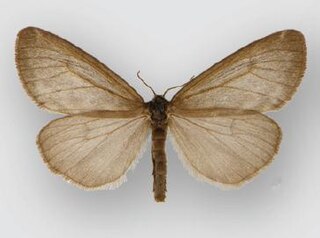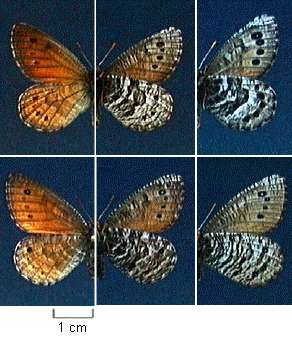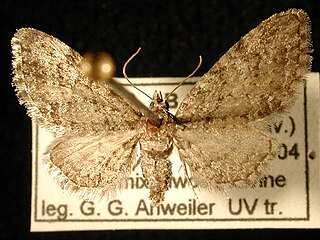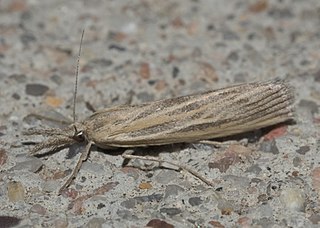
The Oldman River is a river in southern Alberta, Canada. It flows roughly west to east from the Rocky Mountains, through the communities of Fort Macleod, Lethbridge, and on to Grassy Lake, where it joins the Bow River to form the South Saskatchewan River, which eventually drains into the Hudson Bay.

Schinia, commonly called flower moths, is a large genus of moths belonging to the family Noctuidae. The genus has a Holarctic distribution with the vast majority of species being found in North America, many with a very restricted range and larval food plant.
Occidentalia is a monotypic moth genus of the family Crambidae described by Harrison Gray Dyar Jr. and Carl Heinrich in 1927. It contains only one species, Occidentalia comptulatalis, described by George Duryea Hulst in 1886. It is found in North America, where it has been recorded from Alberta, Indiana, Maine, Manitoba, Minnesota, New York, Ontario, Quebec and Saskatchewan.

Dodia albertae is a moth of the family Erebidae. It was described by Harrison Gray Dyar Jr. in 1901. It is found in Canada, Alaska, Siberia west to the Urals, and Mongolia.
Abagrotis nefascia is a moth of the family Noctuidae first described by Smith in 1908. It is found in North America from Alberta and British Columbia down through Massachusetts to California. The species is listed as threatened in the US state of Connecticut.

Abagrotis scopeops is a moth of the family Noctuidae first described by Harrison Gray Dyar Jr. in 1904. It is found in North America from southern British Columbia, south through western Montana, Idaho, Utah and Nevada down to southern California.

Schinia avemensis, the gold-edged gem, is a moth of the family Noctuidae. The species was first described by Harrison Gray Dyar Jr. in 1904.

Euxoa adumbrata, the sordid dart, is a moth of the family Noctuidae. The species was first described by Eduard Friedrich Eversmann in 1842. In North America it is found across northern Canada from Quebec to western Alaska, south to the northern parts of the United States, and in the mountains to Colorado. It is also found in Greenland, the coastal areas of Scandinavia and the Ural. It was recently recorded from Denmark, although this includes Euxoa lidia, which some authors regard to be a valid species.

Archips negundana, the larger boxelder leafroller, is a moth of the family Tortricidae. The species was first described by Harrison Gray Dyar Jr. in 1902. It is found in North America from southern British Columbia to southern Quebec, south to California and Florida.

Dioryctria ponderosae, the ponderosa twig moth, is a moth of the family Pyralidae. The species was first described by Harrison Gray Dyar Jr. in 1914. It is found in North America from Washington and Montana south to California and northern Mexico.
Bandera is a genus of snout moths. It was described by Émile Louis Ragonot in 1887 and is known from the United States.
Bandera binotella is a species of snout moth in the genus Bandera. It was described by Philipp Christoph Zeller in 1872. It is found in North America, including Texas, New Mexico, California, Colorado and Alberta.
Semioscopis aurorella, the aurora flatbody moth, is a species of moth of the family Depressariidae. It was described by Harrison Gray Dyar Jr. in 1902. It is found in Canada from north-central Alberta to south-eastern Ontario, south into the United States between south-central New York and Wisconsin.

Semioscopis merriccella is a species of moth of the family Depressariidae. It was described by Harrison Gray Dyar Jr. in 1902. It is found throughout the northern United States and southern Canada from the east to the west coast.

Melitara subumbrella is a species of snout moth in the genus Melitara. It was described by Harrison Gray Dyar Jr. in 1925. It is widespread in western North America, from southern Alberta and Saskatchewan to southern Arizona, central Texas, southern New Mexico and south-eastern California.
Gazoryctra roseicaput is a moth of the family Hepialidae. It was described by Berthold Neumoegen and Harrison Gray Dyar Jr. in 1893. It is known from the mountains of western North America, including Washington, Oregon, British Columbia and Alberta.

Oeneis uhleri, or Uhler's Arctic, is a species of butterfly in the family Nymphalidae.

Eupithecia columbiata is a moth in the family Geometridae first described by Harrison Gray Dyar Jr. in 1904. It is found in North America from eastern Newfoundland and Labrador to Vancouver Island, south to North Carolina in the east and Colorado in the west.

Agriphila plumbifimbriella is a moth in the family Crambidae. It was described by Harrison Gray Dyar Jr. in 1904. It is found in North America, where it has been recorded from British Columbia, Alberta and the western United States. The habitat consists of grassland areas in mountains and foothills.

Thaumatopsis pexellus, the woolly grass-veneer, is a moth in the family Crambidae. It was described by Philipp Christoph Zeller in 1863. It is found in most of North America. The habitat consists of grasslands.














